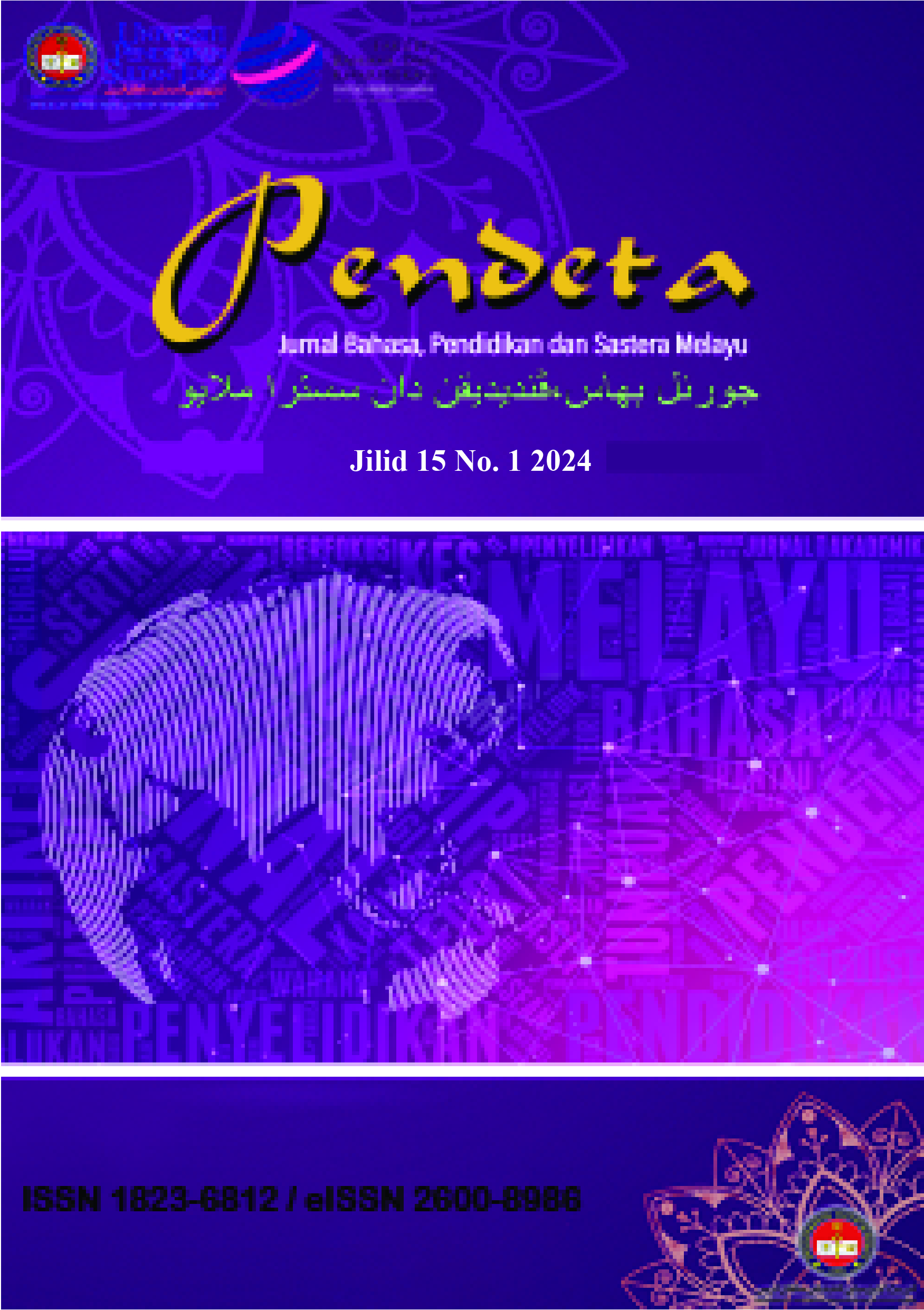Looking for Russian – Tagalog Lexical and Grammatical Equivalents
DOI:
https://doi.org/10.37134/pendeta.vol15.1.fa.1.2024Keywords:
situational model of translation, lexical and grammatical equivalents, demonstrative pronouns, kinship terms, the Russian language, the Tagalog languageAbstract
Analysis of lexical and grammatical equivalents in different languages is an essential and necessary aspect of acquisition of command of a foreign language and translation as a type of speech activity. To do it properly a student must understand that distribution of various components of meaning in languages can differ and word by word translation can cause losses of information that should be compensated by some other means that can be both lexical and grammatical. The Tagalog and Russian languages often use various sets of constituents of meaning in words to describe the world around and the content expressed grammatically in one language can be expressed lexically in the other. The fact that Tagalog is one of the agglutinative languages while Russian is an inflectional language makes the process of translation even more complicated. This article is an attempt to show some differences and similarities in semantic and grammatical components in several groups of words in Tagalog and Russian. Understanding of these peculiarities of the languages can make translation easier for the students.
Downloads
References
Baklanova E. (2017). On Contact-induced Changes in Modern Tagalog: A case study. Mezhcivilizacionnye kontakty v stranakh Yugo-Vostochnoj Aazii: istoricheskie perspektivy i globalizaciya [Intercivilization Contacts in the Countries of the South-East Asia: Historical Perspectives and Globalization]. (In Russian). Saint-Petersburg, 2017. Pp. 329-359.
Castle Corazon & McGonnell Laurence. (2003). Teach Yourself Tagalog, (Second Edition). London: Hodder & Stoughton, 2003.
Catford J.C. (1965). A Linguistic Theory of Translation. Oxford University Press, 1965.
Fjodorov A.V. (1968). Osnovy obshhej teorii perevoda: Lingvisticheskij ocherk. [Theoretical Framework of Translation]. (In Russian). M., 1968.
Frolova E.G. (2019). Yazykovye izmeneniya na Filippinakh v kontekste yazykovoj situacii [Language Changes in the Philippines in the Context of Language Situation]. (In Russian). Moscow, 2019.
Gak V.G., Grigoryev B.B. (2000). Teoriya i praktika perevoda. Francuzskij yazyk. [Translation Theory and Practice. The French Language]. Moscow, Interdialekt+ Publ., 2000.
Jocano F. Landa. (1966). Filipino Social Structure and Value System. Filipino Cultural Heritage. Lecture Series No. 2. Manila: PWU, 1966.
Makarenko V.A. (1990). Tagalskij yazyk. Lingvisticheskij ehnciklopedicheskij slovar. [The Tagalog Language. Linguistic Encyclopaedia]. (In Russian). Moscow, 1990. Pp. 501-502.
Podberezskij I.V. (1974). Sampagita, krest i dollar. [Sampaguita, Cross and Dolar]. (In Russian). Moscow, 1974.
Podberezskij I.V. (1976). Uchebnik tagalskogo yazyka. [Texbook of the Tagalog Language]. (In Russian). Moscow, 1976.
Rachkov G.E. (1981). Vvedenie v morfologiyu sovremennogo tagalskogo yazyka. [Introduction to the Morphology of the Modern Tagalog Language]. (In Russian). Leningrad, 1981.
Reid L.A., Liao Hsiu-Chuan. (2004). A Brief Syntactic Typology of Philippine Languages, 2004. [https://core.ac.uk/download/pdf/32298117.pdf] (28.07.2023).
Retsker Ya. I. (2007). Teoriya perevoda i perevodcheskaya praktika. Ocherki lingvisticheskoj teorii perevoda. [Translation Theory and Translation Practice. Essays on the Linguistic Theory of Translation]. (In Russian). Mosow, 2007.
Rodell Paul A. (2002). Culture and Customs of the Philippines. Westport, CT: Greenwood Publishing Group, 2002.
Schachter P., Otanes Fe T. (1972). Tagalog Reference Grammar. Berkeley, Los Angeles, London:University of California Press, 1972.
Schweitzer A.D. (1973). Perevod i lingvistika (Gazetno-informacionnyj i voenno-publicisticheskij perevod) [Translation and Linguistics (Newspaper and Information and Military-Journalistic Translation)]. (In Russian). Moscow, Voenizdat Publ., 1973.
Schweitzer A.D. (1988). Teoriya perevoda: status, problemy, aspekty. [Translation Theory: Status, Problems, Aspects]. (In Russian). Moscow, Nauka Publ., 1988.
Shkarban L.I. (1995). Grammaticheskij stroj tagalskogo yazyka. [Grammar Structure of the Tagalog Language]. (In Russian). Moscow, 1995.
Stanyukovich M.V. (2010). “Syn betelnogo orekha i lista betelya”: Simvolika areca catechu i piper-betle v folklore i tradicionnoj culture ifugao i drugikh narodov. [‘Son of Betel Nut and Betel Leaf’: the Symbolism of Areca Catechu and Piper Betle in Oral Literature and Traditional Culture of the Ifugao and Other Peoples of the Philippines]. (In Russian). Saint-Petersburg, 2010. Pp. 306-340.
Wolff John U. & Centeno Maria Theresa C., Rau, Der-Hwa. (2002). Pilipino Through Self-Instruction (Revised Edition), Parts 1-3. NY: Cornell SEAP, 2002.
Dictionaries
Cruz M., Ignashev S. (1959). Tagalsko-russkij slovar. [Tagalog-Russian Dictionary]. (In Russian). Moscow, 1959.
Cruz M., Ignashev S. (1965). Russko-tagalskij slovar. [Russian-Tagalog Dictionary]. (In Russian). Moscow, 1965.
English Leo James. (1965). English - Tagalog Dictionary. Department of Education. Republic of the Philippines, 1965.
English Leo James. (1986). Tagalog - English Dictionary. Department of Education. Republic of the Philippines, 1986.
Frolova E.G., Baklanova E.A. (2023). Uchebnyj russko tagalskij slovar. [Training Russian-Tagalog Dictionary]. (In Russian). Moscow, 2023.
Panganiban J.V. (1972). Diksyunaryo - Tesauro Pilipino - Ingles. Quezon, Pilipinas: Manlapaz Publishing Co., 1972.
Rachkov G.E. (2012). Novyj tagalsko-russkij slovar. [New Tagalog-Russian Dictionary]. (In Russian). Volume 1, 2. Saint-Petersburg, 2012.
Santos, Vito C. (1978). VICASSAN’S Pilipino - English Dictionary. National Bookstore, 1978. UP Diksiyonaryong Filipino. (2001). Virgilio Almario, Punong Editor. Quezon City: UP-SWF, 2001.
Zorc David Paul R. (1993). Tagalog Slang Dictionary. Manila: DLSU Press, 1993.
Downloads
Published
How to Cite
Issue
Section
License
Copyright (c) 2024 Elena G. Frolova

This work is licensed under a Creative Commons Attribution-NonCommercial-ShareAlike 4.0 International License.





